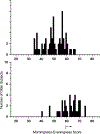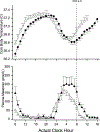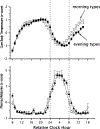Relationship of endogenous circadian melatonin and temperature rhythms to self-reported preference for morning or evening activity in young and older people
- PMID: 10198570
- PMCID: PMC8530273
Relationship of endogenous circadian melatonin and temperature rhythms to self-reported preference for morning or evening activity in young and older people
Abstract
Background: Morningness-eveningness refers to interindividual differences in preferred timing of behavior (i.e., bed and wake times). Older people have earlier wake times and rate themselves as more morning-like than young adults. It has been reported that the phase of circadian rhythms is earlier in morning-types than in evening types, and that older people have earlier phases than young adults. These changes in phase have been considered to be the chronobiological basis of differences in preferred bed and wake times and age-related changes therein. Whether such differences in phase are associated with changes in the phase relationship between endogenous circadian rhythms and the sleep-wake cycle has not been investigated previously.
Methods: We investigated the association between circadian phase, the phase relationship between the sleep-wake cycle and circadian rhythms, and morningness-eveningness, and their interaction with aging. In this circadian rhythm study, 68 young and 40 older subjects participated.
Results: Among the young subjects, the phase of the melatonin and core temperature rhythms occurred earlier in morning than in evening types and the interval between circadian phase and usual wake time was longer in morning types. Thus, while evening types woke at a later clock hour than morning types, morning types actually woke at a later circadian phase. Comparing young and older morning types we found that older morning types had an earlier circadian phase and a shorter phase-wake time interval. The shorter phase-waketime interval in older "morning types" is opposite to the change associated with morningness in young people, and is more similar to young evening types.
Conclusions: These findings demonstrate an association between circadian phase, the relationship between the sleep-wake cycle and circadian phase, and morningness-eveningness in young adults. Furthermore, they demonstrate that age-related changes in phase angle cannot be attributed fully to an age-related shift toward morningness. These findings have important implications for understanding individual preferences in sleep-wake timing and age-related changes in the timing of sleep.
Figures






References
-
- Moore RY: Circadian rhythms: Basic neurobiology and clinical applications. Annu.Rev.Med 1997;48:253–266. - PubMed
-
- Van Cauter E: Diurnal and ultradian rhythms in human endocrine function: A minireview. Horm.Res 1990;34:45–53. - PubMed
-
- Folkard S, Monk TH: Circadian performance rhythms, in Folkard S, Monk TH (eds): Hours of Work: Temporal Factors in Work-Scheduling. New York, John Wiley & Sons; 1985:37–52.
-
- Monk TH: Circadian rhythms in subjective activation, mood, and performance efficiency, in Kryger MH, Roth T, Dement WC (eds): Principles and Prcatice of Sleep Medicine. Philadelphia, W.B.Saunders Company; 1994:321–330.
-
- Kleitman N: Sleep and Wakefulness, Chicago, University of Chicago Press; 1939.
Publication types
MeSH terms
Substances
Grants and funding
LinkOut - more resources
Full Text Sources
Medical
